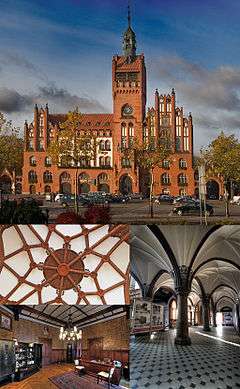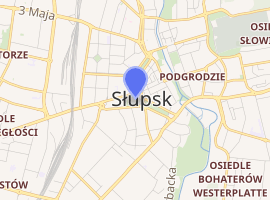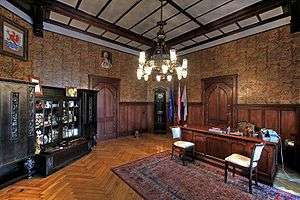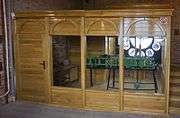Słupsk Town Hall
The Słupsk Town Hall (Polish: Ratusz w Słupsku, German: Rathaus in Stolp) is the chief administrative building of Słupsk, a town in north-western Poland. The town hall was constructed in 1901 under Prussian rule in the Gothic Revival style and is listed in a group of heritage monuments protected by Polish law. One of the most iconic architectural elements of both the structure and the whole town is the 56-meter tall tower with a clock mechanism that has been operating uninterruptedly for 100 years. The tower and terrace are accessible to visitors since 2003.
| Słupsk Town Hall | |
|---|---|
 Słupsk Town Hall | |

| |
| General information | |
| Architectural style | Gothic Revival |
| Town or city | Słupsk |
| Country | Poland |
| Construction started | 1899 |
| Completed | 1901 |
| Design and construction | |
| Architect | Karl Zaar and Rudolf Vahl |
History
The neo-Gothic town hall was built in 1901, near Plac Zwyciestwa (Victory Square). The building remains the official residence of the town council.
The area where the town hall now stands was originally a lake.[1] In the second half of the 19th century, it was filled in with sand from the Northern Wood. From that time, the square's surroundings started to develop into a suburb behind the New Gate. The expansion of the city created a need for a new, bigger town hall; the previous one had been built in 1798, and after a hundred years was beginning to collapse. It was decided to build a new one; the site of the former hospital on Tuwima Street was bought, and an architectural contest was announced.
On 16 and 17 May 1898, the 87 entries in the contest were introduced to the public at the primary school on Deotymy Street. The commission was led by famous architect Hugo Licht, who had won a reputation for his extraordinary design for the New Town Hall in Leipzig. After two days, it selected the Old German Gothic design by Karl Zaar. On 17 July, the first blueprints were drafted by Rudolf Vahl, who included the rosettes on the ceiling, arabesques on the stairs, and the mayor’s desk.
The building as designed would have 23,176 square metres (249,460 sq ft) of floor area. Its cost was estimated as 300,000 marks, which substantially exceeded the town's capacity.
The old town hall was sold, yielding very little profit, and eventually demolished. Local authorities passed legislation under which the site of the old hall could never be used; it remains unbuilt to this day. Meanwhile, construction went ahead quickly on the new building. It was completed on 22 September 1900, and all of the workers were served a free beer. On 5 July 1901, a solemn opening celebration took place.
Notable features

The town hall of Słupsk together with a few other monuments in Poland portrays a lot of elements originating from an authentic interior decoration. With no doubts, the most precious is the mayor’s room which due to its special construction is among the rarest projects in Europe. It is surrounded by 12 walls and is decorated with original furniture and an absolutely phenomenal tapestry. In the room of the second mayor, on the other hand, there is an impressive painting on the wall by Friedrich Klein - Chevalier which portrays hunting for salmons. The piece of art has been cited to be so special that it can be given to the public for the evaluation without hesitation.
The new town hall is mysterious and full of hidden places. For instance, no one knows what the hidden door in the conference room is for. As it later appeared, there is a tiny space behind the door where hardly a man can get. It has been proved that the room has an excellent acoustics. It is laughed at that the place was designed on purpose to hide spies noting the course of significant conferences.
A similar puzzle constitutes a safe that could not be opened for a long time. As it was later discovered it contained a treasure – German water-pipe system plans, and others. As a matter of fact such plans were after the war even more precious than gold. Apart from mysterious places there are also numerous hidden passages and tunnels of an unknown use.
Town hall's clock

Town hall's clock has been working continuously since 1901. ist constructor was a resident of Slupsk, and his name was OTTO PILA. The chimes were added to clock in 1973 (one phrase of Karol Szymanowski's IV Symphony). The load of the clockwork amounts to 36 kg and it is at most 2 seconds slow per day. In 1998 the resident of Slupsk, Jacek Stańczyk, composed town's bugle-call. Every day at midday, the recording of the call, performed by musicians of Polish Philharmonic Sinfonia Baltica, Jerzy Lis, Jan Buczko and Mieczysław Gach (trumpet and 2 French horns) rings out from the town hall's tower.[2]
The Key to United Europe
The Key to United Europe for Slupsk it is a symbol of Polish accession to European Union. On 12 May 2004, the leaders of the youth from all over Poland, represented the Slupsk City, were given the key to Europe in the presence of the Polish First Lady, Mrs. Jolanta Kwaśniewska and the President of Slupsk, Mr. Maciej Kobyliński. The key was handed over by European Commissioner, Mrs. Danuta Huebner. The celebration took place in Brussels Royal Yacht Club. Beforehand it was carried for 12 days from Slupsk to Brussels on 4 yachts under the command of Capitan Krzysztof Baranowski. The event organised by Slupsk City Council under the patronage of Mrs. Jolanta Kwaśniewska.[3]
Polish Eagles' exhibition
The unique collection shows the process of shaping the image of the Coat of arms of Poland from the earliest times (10th century) to modern times, by well-known Słupsk's artist working with metal, co-funder and a director for many years of Tadeusz Czapliński's Puppet Theater "Rainbow". The exhibition consists of pieces of handwork borrowed from the Police School in Słupsk. Presented coat of arms are made on the copper and brass tray. The exhibits are reproduction of original coats of arms of royal princes, military awards, standards, seals (emblem) and coins. The collection was shown in many exhibitions in Poland and Europe.[4]
References
- SSI Słupsk - Słupskie ratusze > Historia ratusza Archived 2010-11-29 at the Wayback Machine
- "Archived copy". Archived from the original on 2011-07-18. Retrieved 2010-08-05.CS1 maint: archived copy as title (link)
- "Archived copy". Archived from the original on 2011-07-18. Retrieved 2010-08-05.CS1 maint: archived copy as title (link)
- "Archived copy". Archived from the original on 2011-07-18. Retrieved 2010-08-05.CS1 maint: archived copy as title (link)
External links
| Wikimedia Commons has media related to Town Hall in Słupsk. |